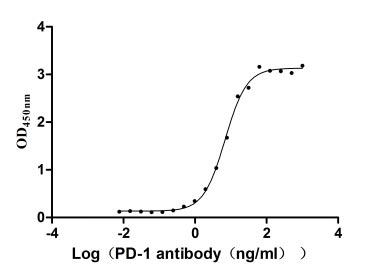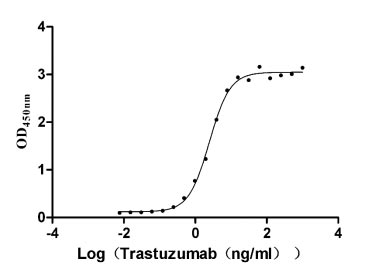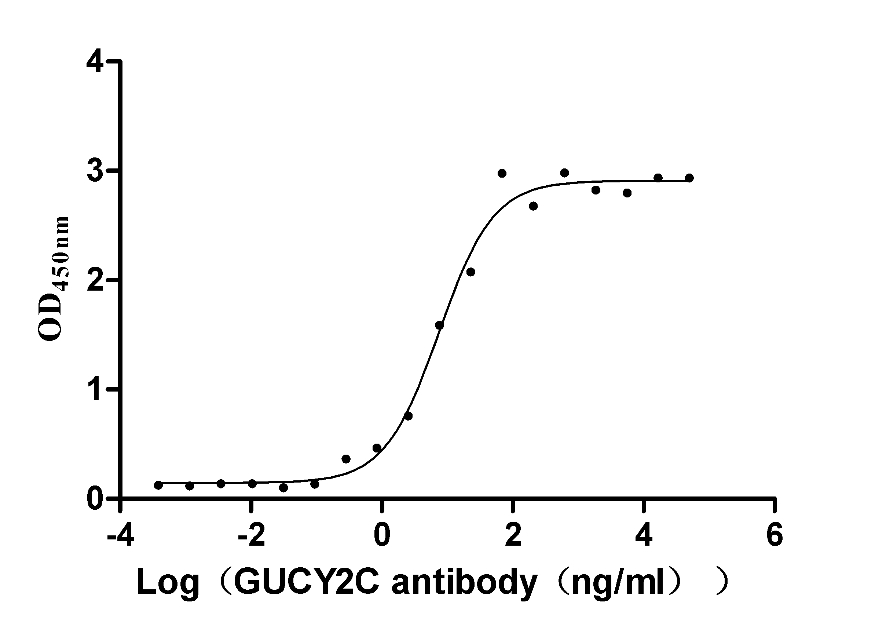Recombinant Human G protein-activated inward rectifier potassium channel 1 (KCNJ3), partial
-
货号:CSB-YP012056HU1
-
规格:
-
来源:Yeast
-
其他:
-
货号:CSB-EP012056HU1
-
规格:
-
来源:E.coli
-
其他:
-
货号:CSB-EP012056HU1-B
-
规格:
-
来源:E.coli
-
共轭:Avi-tag Biotinylated
E. coli biotin ligase (BirA) is highly specific in covalently attaching biotin to the 15 amino acid AviTag peptide. This recombinant protein was biotinylated in vivo by AviTag-BirA technology, which method is BriA catalyzes amide linkage between the biotin and the specific lysine of the AviTag.
-
其他:
-
货号:CSB-BP012056HU1
-
规格:
-
来源:Baculovirus
-
其他:
-
货号:CSB-MP012056HU1
-
规格:
-
来源:Mammalian cell
-
其他:
产品详情
-
纯度:>85% (SDS-PAGE)
-
基因名:
-
Uniprot No.:
-
别名:KCNJ3; GIRK1; G protein-activated inward rectifier potassium channel 1; GIRK-1; Inward rectifier K(+ channel Kir3.1; Potassium channel, inwardly rectifying subfamily J member 3
-
种属:Homo sapiens (Human)
-
蛋白长度:Partial
-
蛋白标签:Tag type will be determined during the manufacturing process.
The tag type will be determined during production process. If you have specified tag type, please tell us and we will develop the specified tag preferentially. -
产品提供形式:Lyophilized powder
Note: We will preferentially ship the format that we have in stock, however, if you have any special requirement for the format, please remark your requirement when placing the order, we will prepare according to your demand. -
复溶:We recommend that this vial be briefly centrifuged prior to opening to bring the contents to the bottom. Please reconstitute protein in deionized sterile water to a concentration of 0.1-1.0 mg/mL.We recommend to add 5-50% of glycerol (final concentration) and aliquot for long-term storage at -20℃/-80℃. Our default final concentration of glycerol is 50%. Customers could use it as reference.
-
储存条件:Store at -20°C/-80°C upon receipt, aliquoting is necessary for mutiple use. Avoid repeated freeze-thaw cycles.
-
保质期:The shelf life is related to many factors, storage state, buffer ingredients, storage temperature and the stability of the protein itself.
Generally, the shelf life of liquid form is 6 months at -20°C/-80°C. The shelf life of lyophilized form is 12 months at -20°C/-80°C. -
货期:Delivery time may differ from different purchasing way or location, please kindly consult your local distributors for specific delivery time.Note: All of our proteins are default shipped with normal blue ice packs, if you request to ship with dry ice, please communicate with us in advance and extra fees will be charged.
-
注意事项:Repeated freezing and thawing is not recommended. Store working aliquots at 4°C for up to one week.
-
Datasheet :Please contact us to get it.
相关产品
靶点详情
-
功能:This potassium channel is controlled by G proteins. Inward rectifier potassium channels are characterized by a greater tendency to allow potassium to flow into the cell rather than out of it. Their voltage dependence is regulated by the concentration of extracellular potassium; as external potassium is raised, the voltage range of the channel opening shifts to more positive voltages. The inward rectification is mainly due to the blockage of outward current by internal magnesium. This receptor plays a crucial role in regulating the heartbeat.
-
基因功能参考文献:
- these data suggest that patients with estrogen receptor positive breast cancer might be stratified into high risk and low risk groups based on the KCNJ3 levels in the tumor PMID: 27835900
- Results clearly corroborate that overexpression of GIRK1 protein exerts profound effects on wound healing, chemoinvasion and cellular motility in the MCF-7 breast cancer cell line suggesting a role to promote invasion and metastasis. PMID: 27519272
- GIRK1/GIRK4 hetero-tetramers are not activated by Na+, but rather are in a permanent state of high responsiveness to G proteins beta-gamma, suggesting that the GIRK1 subunit functions like a GIRK4 subunit with Na+ permanently bound. PMID: 27074664
- The findings of this study suggest that variations in KCNJ3 genes are associated with both mild and severe persistent breast pain after breast cancer surgery. PMID: 25599232
- For KCNJ3 rs7574878, individuals who were heterozygous or homozygous for the rare G allele (TT versus TG+ GG) had a 48% reduction in the odds of reporting preoperative breast pain. PMID: 24392765
- we show that Kir3.1, in the absence of trafficking partner subunits, can exit the endoplasmic reticulum (ER) and reach the Golgi (though not the plasma membrane) PMID: 23368630
- In the dorsal horn of the developing rat, K(ir)3.1 and K(ir)3.2 were expressed at mature levels from birth. PMID: 23219908
- Conformational changes at the Gbetagamma/Kir3 interface were lost when Kir3.1 subunits were replaced. PMID: 23175530
- These data suggest that the KCNJ3 gene is genetically associated with schizophrenia in Asian populations and add further evidence to the "channelopathy theory of psychiatric illnesses". PMID: 21927946
- Kir3.1 channel is involved in the TLR4-mediated signal at an early event by facilitating the recruitment of TLR4 into lipid raft. PMID: 21420934
- halothane predominantly interferes with Gbetagamma-mediated Kir3 currents, such as those functioning during inhibitory synaptic activity PMID: 21044958
- The very high abundance of mRNA's encoding GIRK1 together with the presence of GIRK1 protein suggests a pathophysiological role in breast cancer PMID: 20512921
- We identified several known single nucleotide polymorphisms in KCNJ3 and KCNJ5, but no mutations in either of the genes. PMID: 20110696
- glutamate residue at the C terminus regulates activity -- implications for Andersen Disease (inward rectifier potassium channel 2; IRK2) PMID: 12034888
- that GIRK channels are important functional effectors of the P2Y(12) receptor in human platelets. PMID: 15142872
- GIRK1 and GIRK2 channels, but not GIRK3 or GIRK4, may may activate signaling pathways in development of lung cancer PMID: 16109170
- GIRK1 was overexpressed in breast carcinoma suggesting its involvement in proliferation and oncogenesis and its possible use as a putative pharmaceutical target. PMID: 18498071
- Sar 1 H79G and Rab 1 S25N mutants efficiently blocked the plasma membrane trafficking of the Kir3.1/Kir3.4 complex however they did not block the Gbeta1gamma2/Kir3.1 interaction. Gbeta1-4 can interact with Kir3.1 in the absence of Kir3.4. PMID: 19135528
- S385 identified as in vitro phosphorylation site. Mutation of this residue to alanine resulted in reduced sensitivity of Kir3.1* currents to H89 & Forskolin, confirming in vivo role for this novel site of the Kir3.1 channel subunit in regulation by PKA. PMID: 19151997
显示更多
收起更多
-
亚细胞定位:Membrane; Multi-pass membrane protein.
-
蛋白家族:Inward rectifier-type potassium channel (TC 1.A.2.1) family, KCNJ3 subfamily
-
数据库链接:
HGNC: 6264
OMIM: 601534
KEGG: hsa:3760
STRING: 9606.ENSP00000295101
UniGene: Hs.591606
Most popular with customers
-
Recombinant Human Programmed cell death protein 1 (PDCD1), partial (Active)
Express system: Mammalian cell
Species: Homo sapiens (Human)
-
Recombinant Human Receptor tyrosine-protein kinase erbB-2 (ERBB2), partial (Active)
Express system: Mammalian cell
Species: Homo sapiens (Human)
-
Recombinant Human Heat-stable enterotoxin receptor (GUCY2C), partial (Active)
Express system: Mammalian cell
Species: Homo sapiens (Human)
-
Recombinant Human IGF-like family receptor 1 (IGFLR1), partial (Active)
Express system: Mammalian cell
Species: Homo sapiens (Human)
-
Recombinant Human Claudin-4 (CLDN4)-VLPs (Active)
Express system: Mammalian cell
Species: Homo sapiens (Human)
-
Recombinant Human Carcinoembryonic antigen-related cell adhesion molecule 6 (CEACAM6) (Active)
Express system: Mammalian cell
Species: Homo sapiens (Human)
-
Recombinant Mouse Gastric inhibitory polypeptide receptor (Gipr), partial (Active)
Express system: Mammalian cell
Species: Mus musculus (Mouse)
-
Recombinant Macaca fascicularis CUB domain containing protein 1 (CDCP1), partial (Active)
Express system: Mammalian cell
Species: Macaca fascicularis (Crab-eating macaque) (Cynomolgus monkey)




















